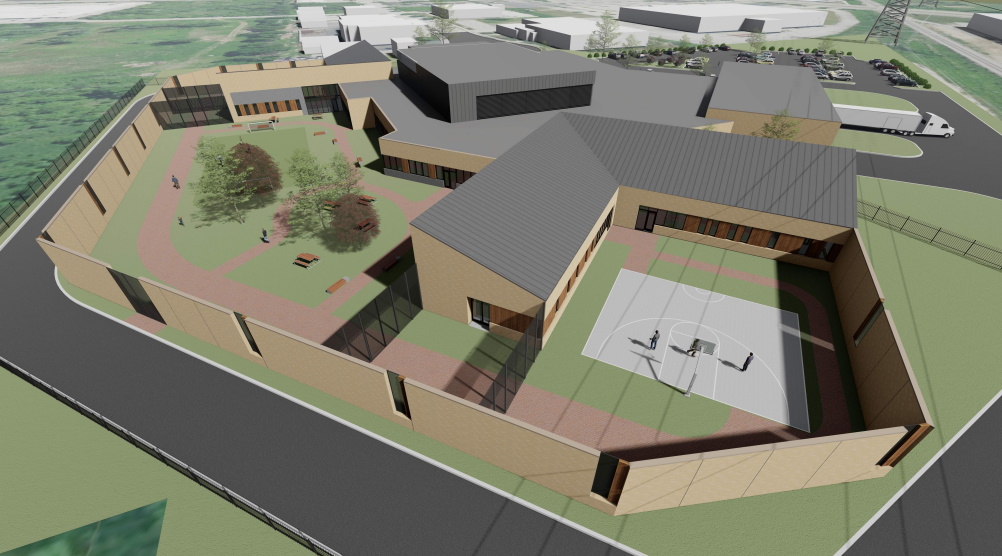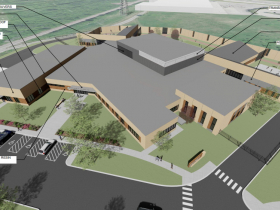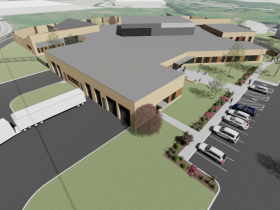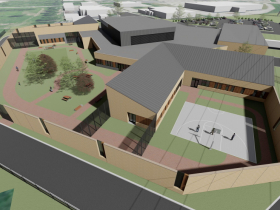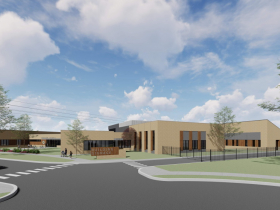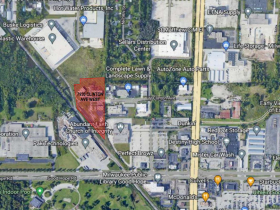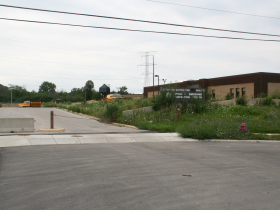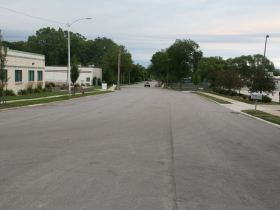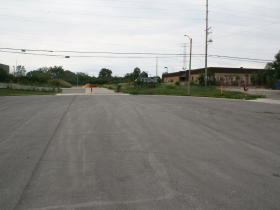New Youth Prison Gains Plan Commission Approval
But some nearby residents oppose project, cite lack of area council member.
Depending on who you listen to, the proposal to develop a 32-bed youth incarceration facility on Milwaukee’s Northwest Side is a welcome plan to rehabilitate offenders closer to home and create jobs or a blighting influence that will bring crime and lower property values.
After a three-and-a-half-hour meeting Monday, the City Plan Commission sided with the former argument, giving the first design approval in the complicated, lengthy process of building a local replacement for the troubled Lincoln Hills youth prison. The Common Council must still approve the plan for a site near N. 76th St. and W. Good Hope Rd.
State Senator Lena Taylor is the leading elected official behind the proposal. “This has not been quick and it has not been easy,” she told the commission.
The new facility would be on a 6.6-acre site at 7930 W. Clinton Ave., located at the western edge of a dead-end street off of N. 76th St. The street, which would see its lighting upgraded by the state, is lined by commercial and industrial businesses. The property, once used as a vehicle emissions testing facility, is bordered to the west by a railroad line and buffered from neighboring properties by a wooded area.
The DOC would construct an approximately 72,000-square-foot building. At the rear, a 16-foot-tall wall would enclose an outdoor recreation area. A ring road would wrap the building, with a six-foot-tall, steel fence enclosing the portion of the road that borders the secured area.
The state’s two existing facilities, Lincoln Hills and the adjacent Copper Lake facility for girls, gained notoriety in 2015 when the poor conditions for inmates and workers were revealed. Taylor said election cycles caused a replacement plan to be delayed, with a proposal for a decentralized, statewide system ultimately adopted in 2018 and $41.8 million in funding for the Milwaukee area replacement approved in April. A court-ordered monitor now reports on conditions at the facilities.
Taylor criticized her one-time political opponent, former Mayor Tom Barrett, as part of the reason a replacement has taken years. “At the time, the executive made it clear that they didn’t want the children to come home,” said the senator. The state publicly considered a site near N. Teutonia Ave. and W. Mill Rd., but ultimately dropped the plan before a city approval process began.
The DOC then considered replacing the Felmers O. Chaney Correctional Center near N. 30th St. and W. Fond du Lac Ave. with an entirely new building. Carr said that proposal was a difficult choice, but one that revealed how committed he was to getting Milwaukee youth out of Lincoln Hills. An advocacy group affiliated with the Chaney facility opposed the plan and suggested more than 10 alternative sites, including the one ultimately selected.
Wendy Volz Daniels, chair of the Chaney advocacy board, was one of the few community members to speak in favor of the proposal Monday. She said her group supports maintaining Chaney as it currently operates.
Taylor said she’s scoured the county looking for a location. “There has no been site that is more secluded. There has been no site that is on a better bus line.” She praised the upkeep of the DOC’s other facilities and also said youth don’t escape or otherwise walk through the area. “I respect the fears that people have, but they are not warranted.”
And despite the assurances from Carr and Taylor, plenty of people expressed a wide variety of concerns ranging from the location to the state’s entire correctional system.
Neighbor Concerns
“Consider another site,” said Carolyn Allen, who lives approximately 500 yards west. She said her neighborhood was beautiful, but would see property values drop with the facility’s presence.
City and state officials said she wouldn’t be able to see the site.
Other numbers expressed concerns about crime. Without explicitly saying who would commit the crimes, Margaret Thorn discussed issues with home break-ins and said more could come. “They take your stuff but what they give you is fear,” she told the commission. Thorn lives along N. 79th St., located across 200 yards to the north, and like Allen’s house, disconnected from the proposed site by the street grid.
“What we are concerned about is seeing home values continually declining as we see crime increase,” said Tresha Lovell. Other nearby residents spoke in opposition.
But Carr said it wouldn’t lower property values. “We are unable to find any evidence that our facilities have negatively impacted property values or crime rates,” he said. “Despite the stigma of a correctional facility, we are committed to being good neighbors.”
He said the proposal has been modified at the request of the Department of City Development (DCD) and other city departments, including improving the fencing, adding more bicycle parking, improving the lighting on W. Clinton Ave. and developing a gardening area.
Taylor’s chief of staff Michelle Bryant said it was a matter of equity to locate the facility in the Milwaukee area. “The bulk of these children we are talking about are Black, they are primarily from Milwaukee,” she said. She said it was also a practical matter. “It’s not like we have a ton of options for where we can place this facility.” Bryant, who once worked at a correctional facility, touted the high pay of the facility as an additional benefit.
DCD is supporting the proposal. “The location of this facility at the end of the Clinton cul de sac is an appropriate location,” said planning manager Sam Leichtling.
“I like the fact that it doesn’t look like a prison from the outside, it looks like a school,” said architect and acting commission chair Allyson Nemec. After asking several questions about the operation and taking extended testimony, the commission asked about the possibility holding the measure until April when a new council member would be installed. Leichtling said the city’s ordinances could possibly allow the council to take the issue out of the commission’s hands before then, blocking an extended hold. A DOC representative also said its purchase option with site owner Poblocki Paving would expire.
Commissioner Willie Smith, head of the Northwest Side Community Development Corporation, made a motion to recommend approval. He added the condition that the state meets quarterly with the Granville Advisory Committee, a city-sponsored citizen-led group focused on improving the area that voted last week to endorse the Clinton Avenue plan. Commissioner Ranell Washington was the lone member to vote against the proposal, but didn’t discuss why. Chair Stephanie Bloomingdale was excused from the meeting.
The facility would be a “Type 1” facility, the most secure the state has for youth offenders. According to DOC official Lance Horozewski, the average stay would be eight to 10 months. Individuals are sentenced to the facility after being convicted of committing a violent offense like battery, but primarily are those that violate terms of a one-year supervision term for offenses like vehicle theft or fleeing. The average age of those in custody is approximately 16 years old.
They would not leave the facility except for court appearances and health care appointments. Most of the traffic to the facility, said project architect Courtney Cooper of Minnesota-based BWBR Architects, would be from employee shift changes, with visitation happening on a regular, scheduled basis.
Most youth offenders, said the DOC officials, do not spend their entire sentence at a Type 1 facility and instead transfer to a state-financed, county-run “Type 2” facility or a lower-level, county-owned detention center like the Vel R. Phillips Juvenile Justice Center. Along with the state’s pursuit of a new Type 1 facility. Milwaukee County is also pursuing the expansion of the Phillips facility.
There are currently 56 boys and nine girls at the Lincoln Hills and Copper Lake facilities said Carr. The new Clinton Ave. facility would be only for boys. The county pays more than $1,000 per day to send offenders to the two facilities, but could save money and keep more individuals closer to home if new facilities are developed.
Renderings and Site
Site
If you think stories like this are important, become a member of Urban Milwaukee and help support real, independent journalism. Plus you get some cool added benefits.
More about the Lincoln Hills and Copper Lake Facilities
- Evers’ Prison Plan Receives Mixed Reviews - WPR Staff - Feb 21st, 2025
- ‘First of its Kind in Wisconsin’ Collaboration Will Support Disabled Incarcerated Youth - Andrew Kennard - Dec 12th, 2024
- MKE County: Tight Budget Forces Difficult Vote on Housing, Juvenile Justice - Graham Kilmer - Nov 1st, 2024
- Letters from Evers, Republicans Show Clash on Juvenile Corrections - Andrew Kennard - Aug 17th, 2024
- Following Counselor Death, Staff, Family Plead for Help At Lincoln Hills - Andrew Kennard - Aug 16th, 2024
- Lawmakers Grill Wisconsin Prison Officials Over Safety, Employee Death at Youth Facility - Sarah Lehr - Aug 7th, 2024
- Future of Lincoln Hills Remains In Limbo - Isiah Holmes - Apr 12th, 2024
- MKE County: County Youth In State Prisons Declining Again - Graham Kilmer - Jan 15th, 2024
- Legislative Committee Okays $6 Million for 2nd Juvenile Facility - Devin Blake - Oct 1st, 2023
- Some Progress, Still Problems at Lincoln Hills - Isiah Holmes - Jul 9th, 2023
Read more about Lincoln Hills and Copper Lake Facilities here
Political Contributions Tracker
Displaying political contributions between people mentioned in this story. Learn more.
- December 1, 2020 - Tom Barrett received $400 from Stephanie Bloomingdale
- October 8, 2018 - Tom Barrett received $500 from Allyson Nemec
- June 28, 2018 - Tom Barrett received $400 from Stephanie Bloomingdale
- May 24, 2017 - Tom Barrett received $400 from Stephanie Bloomingdale
- March 20, 2016 - Tom Barrett received $100 from Sam Leichtling
- March 14, 2016 - Tom Barrett received $400 from Stephanie Bloomingdale
- February 23, 2016 - Chantia Lewis received $100 from Kevin Carr
- January 13, 2016 - Tom Barrett received $100 from Kevin Carr
Eyes on Milwaukee
-
Church, Cupid Partner On Affordable Housing
 Dec 4th, 2023 by Jeramey Jannene
Dec 4th, 2023 by Jeramey Jannene
-
Downtown Building Sells For Nearly Twice Its Assessed Value
 Nov 12th, 2023 by Jeramey Jannene
Nov 12th, 2023 by Jeramey Jannene
-
Immigration Office Moving To 310W Building
 Oct 25th, 2023 by Jeramey Jannene
Oct 25th, 2023 by Jeramey Jannene


